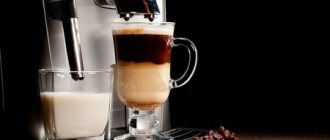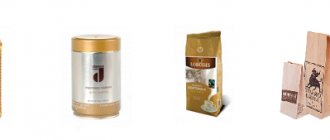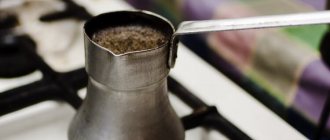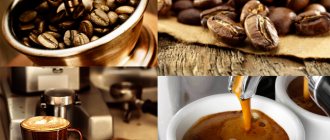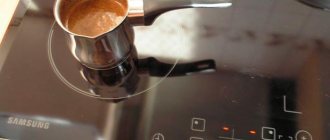Espresso
The classic espresso cup is called a demitasse (from the French demi-tasse, “half cup”). It has a small volume, only 60-90 ml, and is most often made of porcelain. Demitass serves ristretto, espresso, macchiato - small coffee with a drop of milk foam.
A special feature of demitasses suitable for espresso is their thick walls. Thanks to them, you will have time to enjoy your drink before it starts to cool down. By the way, the cup must be warmed up before preparing espresso - espresso is prepared directly into the cup, and if it is cold, the drink will have time to cool down during preparation, which will significantly worsen its taste. If your coffee machine does not have a function for heating dishes, you can simply hold hot water in the cup for a while, and only then prepare espresso in it.
In terms of volume, demitasse is also suitable for double espresso, but this drink is often served in a larger cup, about 150 ml. Firstly, in this case the aroma is revealed more clearly - this is especially noticeable if you rotate the cup a little before the first sip so that the cream starts to move. Secondly, in a large cup it is more convenient to mix the cream and make the drink more homogeneous and balanced in taste. And thirdly, double espresso is not a drink that must be drunk before it cools down: its taste will develop differently at different temperatures, so you can take your time and savor every sip. However, thick walls are also desirable for such a cup, for the same reason: so that the drink does not cool down too quickly.
The shape of an espresso cup also matters: most often, its inner surface will be rounded and tapered downwards, ovoid - this way the drink will be better distributed in the cup. In addition, Brazilian multisensory perception researcher Fabiana Carvalho has shown that round shapes are associated with sweetness, and in a rounded cup the taste of espresso is perceived as sweeter. The edge of the espresso cup is also rounded, which enhances this effect and allows you to feel the body of the drink as creamier.
Fabiana Carvalho's project The Coffee Sensorium is dedicated to the study of specialty coffee in the context of multisensory perception of taste. Photo by sprudge.com.
The founder of the Parisian roasting company L'Arbre de Cafe, Hippolyte Courti, tested more than 400 coffee cups and created his own - a perfectly spherical shape. This cup is made of sandstone and has a rough, “granular” surface that feels reminiscent of ground coffee. Another detail that Kurti paid attention to was the thin edge of the cup. In his opinion, thick edges make our brain perceive espresso as something “heavy” - heavy, dense, viscous. When there is no barrier between our lips and the drink, we don’t load our brains with expectations and try coffee as if “from scratch.” Kurti uses these cups in his own coffee shop, and they can also be found in some restaurants in Paris.
And a little about color: according to my observations, the brightest taste of espresso is felt in a cup that is white on the inside - perhaps because this creates the maximum contrast between the coffee and the dishes. On a bright or black background, the taste is somewhat “lost.” Manufacturers of coffee cups most often make the cups white on the inside, but the outside of the cup can be any color - it’s a matter of taste and mood.
Double espresso in a Redneck Ware 80 ml ceramic cup.
Mugs, cups and glasses for black coffee
1.1. Espresso cups, espresso glasses
The standard volume of espresso is 30-40 ml. Can be double or doppio - 60 ml. This also includes lungo - 80 ml and ristretto - 20 ml. But usually espresso cups have a volume of around 60 ml, although strictly speaking they should be divided into two classes: 40 and 70 ml, that is, for single and double espresso. Made of glass or white, ceramic, porcelain, with thin (less often) or thick (more often) walls, tapering towards the bottom, but this is not necessary.
It is believed that the internal cavity of an espresso cup should be drop-shaped, this way the cream foam is better preserved.
Espresso glasses are commonly referred to as double-walled glass containers.
Double walls provide three advantages at once: they keep the drink hot better and longer, they don’t burn your fingers, and they look cool! But there is a nuance: they are significantly more expensive than ordinary glasses. Even coffee machine manufacturers produce double-walled espresso cups! Delonghi was especially successful in this. Although, of course, they do not make them themselves, but simply contract suppliers in China who put their own label on them. Perhaps, at the moment this is the most common model of thermal cups for espresso on the Russian market. You can buy a set for 2 pieces (article DLSC310) and used to be sold for 6 pieces, but I haven’t seen 6 pieces anywhere for a long time. There is also an option for a set of 6 cups for three different drinks, two of each type of cup. But they are rarely on sale.
However, there is a nuance with these glasses - mediocre quality control, so there is a high probability of running into defects. For example, the “Delonghi” label is crookedly applied. But this is not the worst thing, sometimes there is another defect - a poorly sealed hole in the bottom of the cup, which easily allows moisture to pass through, causing the beautiful transparent cup to fill with condensation or droplets of water after washing. Drying this moisture between the walls is almost impossible. The third nuance is that sometimes there are specimens with a crooked bottom.
All of the listed defects are a consequence of the manual manufacturing method using a blower (DeLonghi in the original calls them “mouth blown”). In theory, the hole should be sealed after blowing, but this is not always done efficiently. Such disadvantages are characteristic of all similar models and other manufacturers made using similar technology. But it's handmade. And it must be said that in the last 3 years the control has been noticeably tightened, and the defects have practically disappeared.
A separate note about Loveramics coffee cups . They produce a variety of glassware, including coffee pairs for almost all popular drinks, ranging from espresso (80 ml) to cups for large cappuccinos and lattes (Loveramics Egg series 300 ml). The material used is thick-walled porcelain with bright colors. The remarkable thing about them is that they are used at many barista championships, cuppings (professional coffee tests) and other thematic events. It is believed that their shape is almost perfectly adjusted for coffee drinks. Plus they look elegant. But they cost accordingly. However, connoisseurs will appreciate it. Update from 02.2022 : Loveramics Egg appeared at almost 2 times cheaper in the Torrefacto fresh coffee store , however, so far only in mourning black.
More classic espresso cups can be purchased in bulk on Yandex.Market. I'll give you a few examples that I personally like. Arrows on the sides scroll through the images. You can click on any picture and go to the store where the coffee cups shown are sold:
1.2. Americano cups, coffee glasses in a broad sense
An Americano is usually a single or double espresso diluted with hot water. You can prepare Americano in a drip or filter coffee maker, or use the special modes of coffee machines. I have two special detailed materials on this equipment: “Americano coffee machine” and “drip coffee makers.”
In any case, Americano usually means weak coffee with a volume of 150 ml to infinity. And due to such a large volume fork, there is no clear concept of “Americano cup”. You can use any suitable volume, even a faceted glass. But usually it’s something ceramic, white, around 200 ml.
Since Americano is a long-lasting drink, the use of thermal mugs with double walls in this case is even more relevant than when choosing glassware for espresso.
Typical examples and a good choice for purchasing at reasonable prices on Yandex.Market. Below are examples of the specimens that I liked (the selection is purely subjective).
Cappuccino
When choosing a cappuccino cup, you should pay attention to the shape: a slightly narrower one at the bottom, with a wide neck, would be optimal. For example, this is what Loveramics look like - the official cups of the world latte art championship. This cup is convenient for mixing coffee and milk, and the wide surface allows you to create designs using milk foam. The suitable cup size for this drink is 150-190 ml. Professional cappuccino ware also has thick walls to maintain a stable temperature of the drink. In addition, in heavy and thick-walled containers, the taste is perceived as creamier, which is also very important for maximum enjoyment of cappuccino.
Flat white and latte
There are no clear requirements for glassware for these drinks; in different establishments they are served in different ways: in glass glasses, in cappuccino cups, in ordinary mugs... Unfortunately, I did not find reliable information about why this happened, so I share my assumptions.
A flat white is not just a “small strong cappuccino”, it is a small drink (up to 200 ml) made with double espresso (or double ristretto) with a minimum amount of foam. It is often served in a cut glass, and this is another difference from cappuccino. In general, this is convenient: you can visually estimate the height of the milk foam - it should be about 5 mm. Since the drink is small in volume, you don’t have to worry about it getting cold in the glass, because you can drink it quickly. And we don’t expect the same creaminess as in a cappuccino from a flat white, so tricks like thick walls and a rounded edge are not particularly important here.
The tradition of serving latte in a glass apparently comes from latte macchiato, a three-layer coffee cocktail served in an Irish glass. For latte macchiato, the appearance of the drink is especially important: a layer of warm milk, a layer of espresso and a layer of milk foam - the smoother and more contrasting they are, the higher the professionalism of the barista (but this is not certain). Nowadays, a latte is understood as a large portion of coffee with milk - about 300-350 ml. It is prepared in different ways: some pour ready-made espresso into heated milk (without worrying about the layers, however), others add milk to espresso, creating latte art on the surface. When serving a latte in a transparent glass, you can admire the pleasant shade of coffee with milk, but from a tall mug it is more convenient to drink it, and it will cool down more slowly. A large wide cup (like for a cappuccino), in my opinion, is not the best option for a latte, since there is less milk foam in this drink and it will be too thin on the surface of a large cup.
Coffee cup volume
A noble drink, which is coffee, requires not only compliance with the exact preparation recipe, but also the appropriate “framing”. That is, worthy dishes that you will be pleased to hold in your hands. In this matter, everything is important: the material of the cup, its design and, of course, volume. This all applies to coffee etiquette, which will help you enjoy your perfect coffee ritual day after day.
In today's article we will tell you what volume a coffee cup should have. And why certain sizes should be used for pouring a particular type of coffee-based drink.
Volume of a coffee cup: pay attention to the type of coffee
All existing coffee utensils differ in their purpose. Therefore, it is not at all surprising that every popular recipe for making coffee has its own utensils.
Espresso cups
This type of classic, standard coffee requires special treatment. To use it, use very small cups. As a rule, these are tiny dishes, the volume of which ranges from 30-45 ml.
It can also be served in slightly larger cups, which have a volume of 50-70 ml. If you like to enjoy a coffee drink at home, then you can easily use dishes with a capacity of 60-90 ml.
Why should you choose cups of this size?
This recommendation should be followed in order to preserve the taste and aroma of traditional espresso as much as possible. According to this recipe, coffee should be made in small portions. At the same time, it is necessary to ensure that it maintains its temperature for the longest possible period of time.
This is useful to know: in modern coffee shops in our country you can increasingly find espresso served in 90 ml cups. This allows establishment owners to save on the purchase of coffee utensils. After all, other types of espresso can be served in a cup of this size. For example, lungo or ristretto.
Let's talk about oriental coffee utensils
This drink has a strong, unique taste. Therefore, in order to preserve its taste characteristics, temperature and aroma, it is recommended to serve it in cups designed for a volume of 70-90 ml.
Our baristas often pour the drink into Demitasse cups. Inside they are ovoid in shape and have significant wall thickness. This allows the oriental coffee to remain hot for as long as possible. This cup option is also suitable for most coffee recipes that involve brewing the drink by hand.
Why exactly this volume?
Oriental coffee is characterized by a fairly rich, strong taste. One serving of the drink contains a considerable “dose” of caffeine, so it should be served in small containers.
Good to know: some oriental-style coffee recipes have a very pronounced strength. Therefore, it is recommended to use ceramic or porcelain cups with a volume of 50 ml for them.
Choosing a cappuccino cup
This type of coffee drink is prepared with a large amount of milk and high milk foam. Therefore, it is necessary to use a much larger cup than for espresso or oriental coffee.
That is why the standard volume of a cappuccino cup is considered to be 170-220 ml. Not worth it anymore. After all, with regards to cappuccino, coffee etiquette says the following: a portion of the drink should be flush with the edges of the cup or even protrude slightly beyond them.
Why is this volume ideal for cappuccino?
The classic variation of the drink is prepared on the basis of espresso and milk (in a ratio of 1 to 2). Do not forget that the drink has a high foam, which will also require a lot of space. Among other things, this cup can be used to serve lungo or espresso with the addition of cream. Therefore, this version of the coffee cup can be called almost universal.
Features of cup volume for Americano
Highly diluted espresso has a volume of 180 to 200 ml. And most often during the day they select dishes whose capacity ranges from 200-220 ml. In some establishments, it is quite common for the barista to pour Americano into a cappuccino cup. Preliminarily making the volume of coffee-based drinks the same.
Why such a volume? Traditionally, highly diluted espresso has a volume of 180 ml. But it is believed that the surface of Americano should not reach the edges. Therefore, experts pour the drink into a larger cup.
Latte cup
The peculiarity of this drink is the large volume of liquid. To prepare a classic latte, you need at least 150 ml of milk. That is why the volume of the cup for this coffee drink must be much larger. As a rule, the drink is served in glasses with a volume of 220 to 300 ml. However, there is also a 360 ml version.
What size should a Frappuccino cup be?
This coffee cocktail has one of the largest volumes. Therefore, barista etiquette states that it should be poured into containers with a capacity starting from 350 ml. It is known that a large portion of Frappuccino can easily reach half a liter. It is the volume for this type of coffee that should be as large as possible.
Attention: Frappuccino is more considered a coffee dessert, so you should use special dessert glasses to serve it.
Advice: if you choose a cup for alternative brewing coffee (using a French press, geyser coffee maker, etc.), then it is recommended to pay attention to dishes that have a volume of 200-220 ml.
Choosing a coffee cup for home, office and coffee shop
Drinking coffee at home
In this case, you should pay attention to cups that have a volume of 170-200 ml. For most traditional drink options, this volume will be more than enough. This type of dishware is also ideal for preparing coffee in a cezve.
To the office
For the office, it is recommended to choose a cup with a universal capacity of 150-170 ml. By the way, psychologists recommend choosing a neutral color scheme for office coffee cups.
Choosing a cup for a coffee shop
Experts recommend getting three types of cups at once:
- 70-90 ml – for espresso and drinks prepared on its basis;
- 180-220 – for Americano and classic cappuccino;
- 280-360 – for latte and frappe.
It is recommended to purchase all types of cups from the same manufacturer. The uniformity of the dishes will emphasize the style of the establishment. Plus, don't forget that if you buy in bulk, you can save some money by getting a discount.
Which drink requires cups?
- Strong coffee. It is believed that the stronger the drink, the smaller the container should be. If you prefer this type of coffee drink, we recommend sticking to 100 ml cups.
- Coffee drinks. If you drink coffee in large volumes or prefer to dilute it with dairy products or all kinds of toppings, then you should pay attention to coffee cups with a volume of 200-300 ml.
Remember: it is better to purchase a product with thick walls. While thin-walled porcelain cups look nice, they won't keep your drink warm.
Selecting a coffee pair
If you decide to buy a coffee pair, you have to make a difficult choice. Such items are produced regularly and in large volumes, so it may be difficult for you to decide on the necessary, suitable volume.
When choosing a coffee pair, it is recommended to follow several rules:
- Small cups with a volume of up to 90 ml are recommended for those who love and know how to cook it.
- Cups of 180-220 ml are considered an ideal option for those who like to drink coffee in large volumes. Or he prefers to add dairy products to the drink.
A volume of 150-170 ml has long been considered universal. After all, it is suitable for coffee prepared according to any recipe. By the way, this version of the cup is considered an excellent gift for a person whose tastes you know very little or not well enough.
Remember that choosing the size of a coffee cup is a purely personal matter. However, with a few tips, you can buy coffeeware not only for yourself, but also as a gift.
Coffee cup volume
Number of votes: 150 3
5
1
150
Was the information helpful? Rate and leave a comment? Better yet, share!
Comments
We will be glad if you share your opinion or add to a note or article.
Purover
When brewing coffee in various pour-overs, we want to maximize its taste and aroma. And here the dishes we use also matter. Decanter
A decanter, or server, is a container in which pour-over coffee is brewed (and served). It can look different, but the most important thing is that it should have a wide base and a narrowed (but not too narrow) neck. For example, you can look at Hario decanters or remember what a Chemex looks like - it is both a funnel and a decanter.
Decanters are designed to aerate coffee, an idea coffee professionals borrowed from sommeliers. When the drink rotates in the server, volatile substances will be released, which will make the aroma of the coffee brighter and help you better feel its taste. In addition, this will mix the different layers of coffee extraction and make the drink more homogeneous.
How to choose espresso cups?
A few simple rules to help you make the right choice.
- Material . Thick porcelain or ceramics with a good, high-quality internal coating are preferable. Fashionable glass cups do not provide heat retention, and the drink in them does not look very attractive.
Espresso cups should not be thin-walled; coffee in such containers will quickly lose its taste.
- Form . Classic, trapezoidal. In it, the aroma of the drink is revealed more fully, and the coffee cools down more slowly.
- Volume . For those who cook in a coffee machine and drink espresso without additives, 35-40 ml cups are suitable. For those who brew coffee in a cezve or like to treat themselves to espresso with sugar and cream, we recommend larger cups, up to 70 ml.
- Manufacturer . The dishes are produced by hundreds of companies in Europe and Asia. Most often you will find products of Chinese origin. Among inexpensive options, Tescoma cups are very good - thick porcelain, pleasant vanilla color, decent quality. A coffee pair costs 335 rubles. Tableware from the Italian brand Pellini is more expensive, but is notable for its particularly durable enamel interior coating, which does not crack even from prolonged exposure to hot coffee. The cost of an espresso cup and saucer starts from 1,200 rubles.
Popular branded tableware with logos of coffee producers is ordered from the same factories in third world countries and simply decorated with the desired logo.
- Price . Inexpensive cups can be bought at a price of 75-150 rubles per piece. Good quality dishes from a well-known brand will cost from 250 to 500 rubles, and luxury segment products cost from 1000 rubles and more.
- Design . Traditionally they are produced in white or vanilla. Fashion trends periodically force manufacturers to create very bright or patterned cups, but such trends are fleeting and do not last more than one season.
Cup
Coffee brewed in pour over is served in small wide cups or smooth glasses. Usually you don’t pour the whole drink into a cup, but add small portions from the decanter. This is done in order to try coffee at different temperatures: as it cools, the coffee changes, revealing its acidity and sweetness, and the nuances of taste are better felt in a warm drink than in a hot one. Properly brewed coffee will be tasty even when it has completely cooled down.
It is worth mentioning separately about the shapes of cups for black coffee, since the difference in shape allows you to experience dramatic changes in taste. One of the most vivid taste experiences for me was getting acquainted with KRUVE glasses, the creation of which took into account many scientifically proven factors that influence taste. They are made of borosilicate glass and have different shapes: the first glass is narrow and long, the second is onion-shaped, more open and with a wider surface area. As a result, the same coffee in the first glass is perceived as sweeter and denser, and in the second - as light and bright.
Here are Figgjo Oslo cups from Tim Wendelboe. Tulip, with a wide base and tapered top, is designed for low acidity coffees and helps bring out the sweetness. Split, in which both the base and top are expanded, is intended for acidic coffee - both aroma and acidity are revealed brighter in this form. Open is a U-shaped cup for a balanced, fruity coffee. The fun thing, Tim says, is playing with different shapes and different coffees, changing the perception of the taste.
Photo andershusa.com.
Mugs, cups and glasses for milk and coffee drinks
2.1. Cappuccino cups, mugs
Cappuccino is made from three equal parts: a third of espresso, a third of milk, a third of milk foam, the total volume is usually 120-180 ml, depending on what the drink is based on: 40 ml espresso or lungo 50-60 ml.
Accordingly, cups are used of approximately the same volume - this means that the milk foam is either flush with the edges, or even higher. Typically the cups are white, made of ceramic or porcelain, thick-walled, squat, with relatively wide edges. It is not customary to pour into glass, although this option also occurs and looks beautiful. Here you can recall the double-wall glass option from Delonghi. Set of 6 pieces has the article number DLSC301, the pros and cons are similar to espresso glasses from the same company - see above.
2.2. Glasses, cups and mugs for latte
Here I will immediately explain that many people are confused about the concepts. Latte is another word for “coffee with milk”, in the French style – “Café au Lait”. And there is also latte macchiato - this is a completely different drink, about cups for it - below.
So, a latte usually means everything the same as a cappuccino, but some of the milk is two or more times heavier. That is, a quarter espresso, two quarters milk and a quarter milk foam. The proportions of milk and foam may gravitate even more towards the dairy component.
The volume of the drink is usually around 200-240 ml. Latte cup - the same volume. The very shape and material of the mug is similar to a cappuccino cup, white, thick-walled, made of ceramic or porcelain; glass is rarely used.
2.3. Glasses for latte macchiato
So, latte macchiato is also made from espresso, milk and milk foam, but the sequence of adding ingredients to the drink is different. First, heated and frothed milk is poured into a latte macchiato cup, then a shot of espresso is added. The espresso is placed in the middle and creates a beautiful three-layer drink.
This is why latte macchiato glasses are always transparent and glass. There are double-walled ones. Due to the overall large volume of the drink (250-350 ml) - tall, 13-15 cm, slightly expanding at the top. Irish glasses are also great. I will say more, latte macchiato is usually served in Irish glass glasses with a volume of about 300 ml.
Delonghi makes branded latte macchiato glasses, but I find them not very suitable due to their small capacity - 220 ml. They did this deliberately so that their glasses would fit under the low dispensers of the ESAM series coffee machines such as the popular Delonghi ESAM 3500/4500, but owners of other equipment with higher dispensers should not limit themselves.
Why it's better not to drink from paper
Even putting the environment aside, paper cups are not the best choice for coffee. Firstly, they are thin and light - which means that black coffee will burn your hands, and a perfectly prepared cappuccino will lose its creaminess. Secondly, the taste of paper will be added to the pour over descriptors - and this is not what you want to smell in good coffee. Thirdly, if you go outside with a paper cup in winter, the coffee will cool down too quickly. Finally, we cover the coffee with a lid, blocking the perception of aroma and depriving ourselves of the brightness of the taste.
And a little more about textures
I am a kinesthetic person, and tactile sensations are very important to me, including (I would even say, especially) from the dishes from which I drink my favorite drink. In coffee shops, I always pay attention to how much I like holding the cup in my hands. My favorite cups are made by the ceramic workshop Redneck Ware: they have a rough surface, very pleasant to the touch, and a smooth, glossy edge - that is, with each sip you can simultaneously feel two completely different textures. This makes the cup experience brighter.
In general, the ideal coffee cup can be absolutely anything: created according to all the rules or sculpted by hand in a ceramic workshop, bought at your favorite coffee shop or accidentally found at a flea market... The main thing is that you like the coffee you drink from it!
Read the article on our channel in Yandex.Zen
Features of volume and shape
It is known that strong coffee is served in original small cups. The shape of an inverted pyramid and the miniature size of the vessel will help keep the drink tart and hot; it is drunk in literally 2-3 sips, enjoying the rich taste.
For a coffee cocktail you will need large containers. The elongated shape of the glass allows you to evenly arrange the layers of the drink.
Coffee with milk requires a mug that can hold at least 170 ml. Airy milk foam takes up a lot of space.
Color and material of manufacture
A variety of materials are used to make coffee utensils, such as porcelain, glass, earthenware or ceramics. For those who like to save money, cups are made from plastic. However, cheap material is not able to convey taste and aroma.
The ideal material for making tableware is porcelain. Unfortunately, the cost of such cups is high and not everyone can afford it.
The best option is glass ceramic cookware. Reasonable price and good quality attract most coffee consumers. The colors and shapes of glass ceramic cups may vary. This gives you the opportunity to experiment with serving the drink.
When purchasing any coffee cup, inspect the inside surface. It should be even and smooth, glossy, without cracks or chips.
A common material for making mugs is glass. Inexpensive, clear glassware looks attractive, whether it's a coffee cup or a tea glass.




